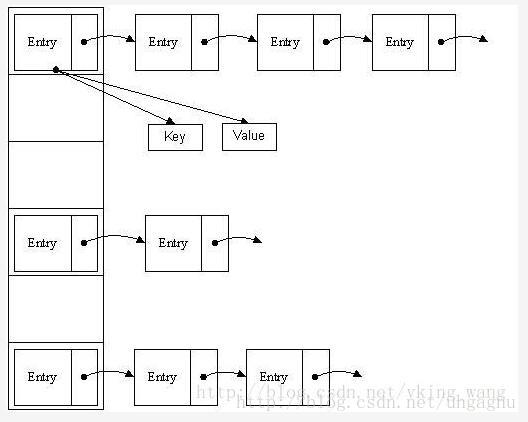HashMap的底层原理
简单说: 底层原理就是采用数组加链表:


两张图片很清晰地表明存储结构:
既然是线性数组,为什么能随机存取?这里HashMap用了一个小算法,大致是这样实现:
// 存储时:
int hash = key.hashCode(); // 这个hashCode方法这里不详述,只要理解每个key的hash是一个固定的int值
int index = hash % Entry[].length;
Entry[index] = value;
// 取值时:
int hash = key.hashCode();
int index = hash % Entry[].length;
return Entry[index];
HashMap的底层原理的更多相关文章
- HashMap的底层原理(jdk1.7.0_79)
前言 在Java中我们最常用的集合类毫无疑问就是Map,其中HashMap作为Map最重要的实现类在我们代码中出现的评率也是很高的. 我们对HashMap最常用的操作就是put和get了,那么你知道它 ...
- 谈一下HashMap的底层原理是什么?
底层原理:Map + 无序 + 键唯一 + 哈希表 (数组+Entry)+ 存取值 1.HashMap是Map接口的实现类.实现HashMap对数据的操作,允许有一个null键,多个null值. Co ...
- HashMap的底层原理 cr:csdn:zhangshixi
1. HashMap概述: HashMap是基于哈希表的Map接口的非同步实现.此实现提供所有可选的映射操作,并允许使用null值和null键.此类不保证映射的顺序,特别是它不保证该顺序恒久不变 ...
- 深度解析HashMap集合底层原理
目录 前置知识 ==和equals的区别 为什么要重写equals和HashCode 时间复杂度 (不带符号右移) >>> ^异或运算 &(与运算) 位移操作:1<&l ...
- 浅谈HashMap 的底层原理
本文整理自漫画:什么是HashMap? -小灰的文章 .已获得作者授权. HashMap 是一个用于存储Key-Value 键值对的集合,每一个键值对也叫做Entry.这些个Entry 分散存储在一个 ...
- HashMap 的底层原理
1. HashMap的数据结构 数据结构中有数组和链表来实现对数据的存储,但这两者基本上是两个极端. 数组 数组存储区间是连续的,占用内存严重,故空间复杂的很大.但数组的二分查找时间复杂度小,为O(1 ...
- 最简单的HashMap底层原理介绍
HashMap 底层原理 1.HashMap底层概述 2.JDK1.7实现方式 3.JDK1.8实现方式 4.关键名词 5.相关问题 1.HashMap底层概述 在JDK1.7中HashMap采用的 ...
- HashMap的底层实现原理
HashMap的底层实现原理1,属性static final int MAX_CAPACITY = 1 << 30;//1073741824(十进制)0100000000000000000 ...
- HashMap底层原理分析(put、get方法)
1.HashMap底层原理分析(put.get方法) HashMap底层是通过数组加链表的结构来实现的.HashMap通过计算key的hashCode来计算hash值,只要hashCode一样,那ha ...
随机推荐
- Rwordseg使用
#用于下载安装rJava 和 Rwordseg,如果安装了就注释掉 install.packages("rJava") install.packages("Rwordse ...
- strstr()函数实现
/* 函数要求:写一个函数模拟strstr()函数,设计中不得使用其他库函数. 函数原型:const char *strstr(const char *str1,const char *str2); ...
- 【原】Java学习笔记031 - 常用类
package cn.temptation; public class Sample01 { public static void main(String[] args) { /* * 类 Math: ...
- 使用Restify+superagent做数据转发
最近为了解决跨域问题,做了一个Node数据转发服务器,使用到了Restify和superagent. Restify 是nodejs的模块.虽然restify的API或多或少的参考了express,但 ...
- 【BZOJ4552】排序(线段树,二分答案)
[BZOJ4552]排序(线段树,二分答案) 题面 BZOJ 题解 好神的题啊 直接排序我们做不到 怎么维护? 考虑一下,如果我们随便假设一个答案 怎么检验它是否成立? 把这个数设成\(1\),其他的 ...
- [Luogu2444][POI2000]病毒
Luogu sol 如果存在一个合法的无限长的串,那势必说明在\(AC\)自动机上存在一个合法的环.由此转化为判环,只要判断搜到的点是否已经在搜索栈中即可. code #include<cstd ...
- 什么是Docker??
Docker是一个轻量级虚拟机,也是一种Linux容器,它突破了以往的沙盒技术,解放了应用部署,让PaaS的应用场景更为广泛. docker是通过内核虚拟化技术((namespaces及cgr ...
- C++中不同变量、函数在内存中的内存情况《转》
一.一个C++编译的程序占用的内存分为以下几个部分 1.栈区:由编译器自动分配 存放函数的参数值,局部变量的值等,操作方式类似于数据结构中的栈. 2.堆区:一般由程序员分配释放,若程序员不释放,程序结 ...
- 树莓派centos安装的基本配置
萌新再发一帖,这篇文章呢主要是为大家在树莓派上安装centos以后提供一个问题的解决方案. 首先我呢觉得好奇就在某宝上花了两百来块钱买了一套树莓派,很多人喜欢在树莓派上安装Debian,我呢更青睐用R ...
- 无需安装Oracle Client连接Oracle数据库
介绍 当我们采用 ODP.NET 检索Oracle 数据库的时候,Oracle客户端是必须安装.假如当时电脑上没有安装Oracle客户端,就不能这么用了,这时候Oracle.ManagedDataAc ...
